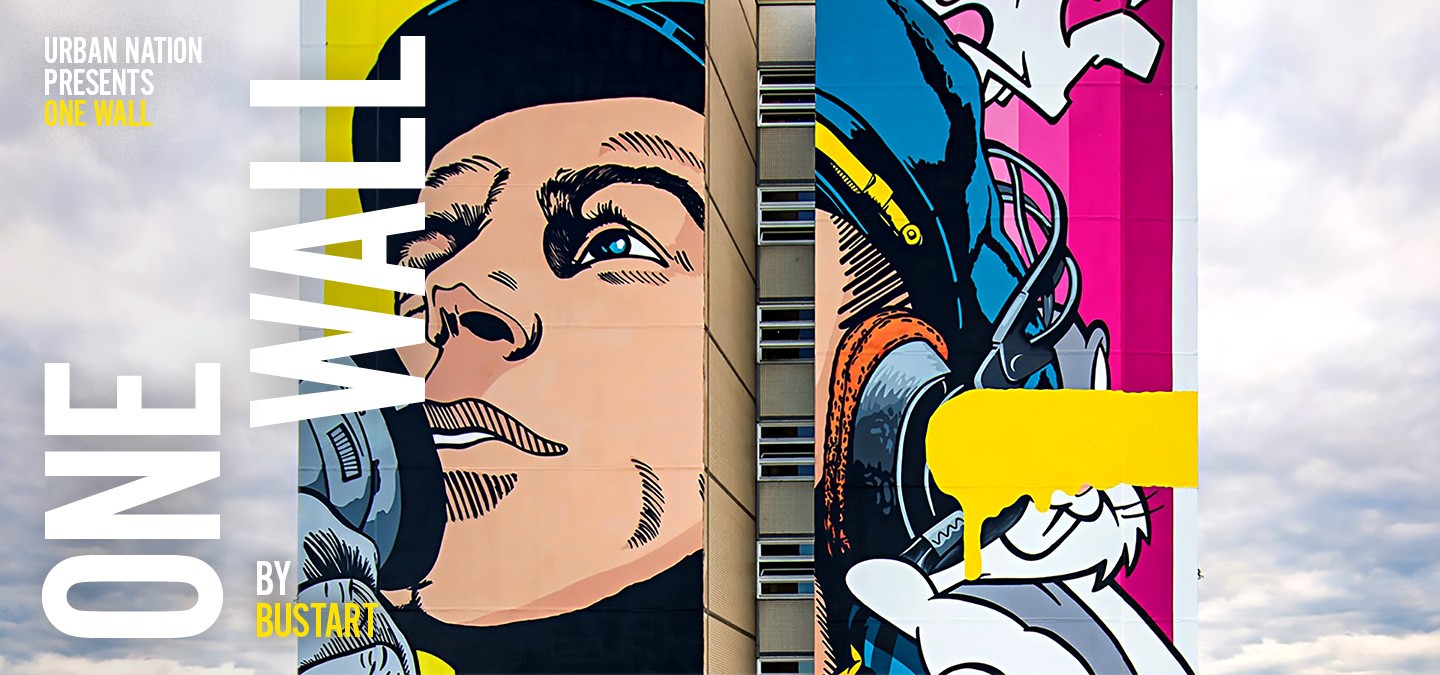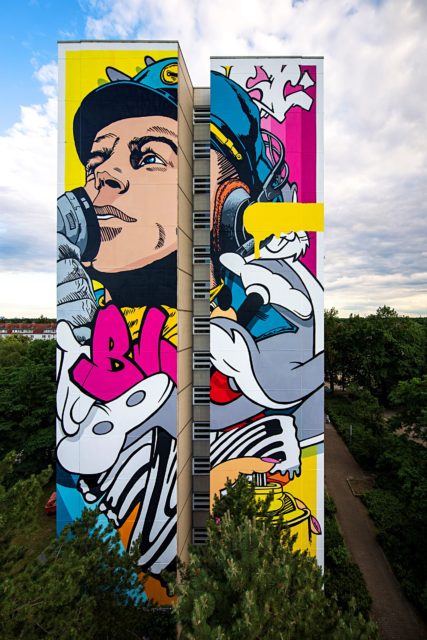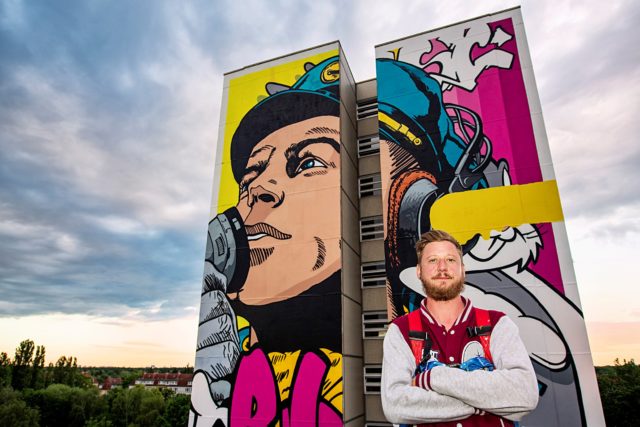
URBAN NATION X BustArt
- July 2, 2020
Graffiti pop at Artpark Tegel.Giant collage commemorates “Otto Lilienthal” airport.

Swiss artist BustArt’s newly created mural on the lake-facing facade of Neheimer Strasse 4, entitled “Departure”, establishes a connection to the “Otto Lilienthal” airport in Tegel, which is scheduled to close soon.From this week onwards, those who live next to Artpark Tegel will be able to look out on the cartoon-like portrait of a pilot – maybe even with a relieved smile, in view of the fact that the scheduled closure of the airport dragged on for many years. Tegel Airport, whose air traffic also always took place above the heads of the local residents, now looks likely to really close at the end of November 2020. Every year, the URBAN NATION MUSEUM FOR URBAN CONTEMPORARY ART invites five or six national and international artists to create a wall mural in the Berlin cityscape as a commentary on current issues. Swiss artist BustArt took up museum director Jan Sauerwald’s invitation and designed a mural for the residential building’s 43 x 16 metre facade.“For the very last time, the pilot radios the tower that he is “ready for departure”. I wanted my work to commemorate the hopefully soon closed Tegel Airport. In future, instead of planes taking off and landing, the only sound you’ll hear around here will be the wind. I have incorporated images by Roy Lichtenstein as well as classic graffiti elements. It’s the largest graffiti pop artwork I have realised so far,” says the artist BustArt.The richly detailed work serves as an introduction to the graffiti pop style invented by BustArt. Since the late 1990s, the techniques employed by the artist, graffiti, paste-ups and sampling, have increasingly moved towards pop art. He combines various western cartoon and popular culture characters and citations with each other, literally making them clash, which results in a unique style mix. The pilot’s face therefore resembles a Roy Lichtenstein character, and the exaggerated brush strokes also reference the characteristic style of contemporary art’s most famous pop artist. The spray can held by a woman’s hand, on the other hand, also establishes a graffiti context and cites a famous work by Lichtenstein. The connection between graffiti and popular culture illustrated here is one of the striking inherent characteristics of graffiti: as a youth culture, this art form has always made use of elements from the rich treasure trove of US pop and cartoon culture. The numerous citations and figurative characters were not only a by-product but often also the main elements of a piece.BustArt’s collage-style realisations of this connection are like a kind of laboratory for aesthetic fieldwork where symbols, super heroes and pop characters are concerned. His “research” results in dizzying image creations that visually illustrate the style mix and the citations as well as the process of re-using subjects and characters.“This year, the works of the artists within the scope of out ONE WALL programme have intensively addressed the subject of illustrations in popular and street art culture. Seeing how differentiated and differently all of the artists address various art disciplines makes it an exciting experience for the audience. We are therefore even more delighted that BustArt took up our invitation and has added yet another artistic highlight to Artpark Tegel,” says Jan Sauerwald, the director of the URBAN NATION museum.

About BustArt
BustArt’s career in the arts began in 1999 with classic graffiti. In the late 2000s, he developed his passion further by starting to combine letters with cartoon characters. BustArt is a neo-pop artist whose works are inspired by characters from US and European cartoons from the 1950s through to the 1990s, which he dissociates from their original contexts and combines in new ways, thereby resurrecting the imaginary worlds of his own childhood. BustArt’s works are easily recognisable, due to his use of characters that are typical for this medium, such as Donald Duck, Mickey Mouse or heroes from the popular Marvel comics. He also establishes connections to US pop artists such as Roy Lichtenstein, for example, and the cultural revolution in contemporary art they initiated.
About the ONE WALL programme
With BustArt’s ONE WALL, URBAN NATION has created a further work of art in the public space that is intended to be a commentary on developments in the local neighbourhood and hopes to inspire those who see it to think. The ONE WALL programme is curated by the director of the URBAN NATION museum, Jan Sauerwald.
Contact details
BustArt and Jan Sauerwald are available for interviews. If you are interested in interviewing either of them, please contact us at pr@urban-nation.com.You can find free downloadable image material here. For more information, please go to urban-nation.com.Follow URBAN NATION on Instagram and Facebook.